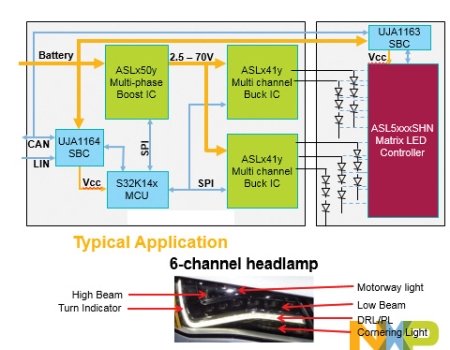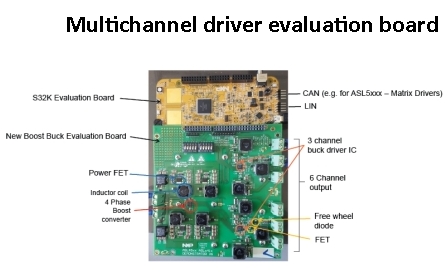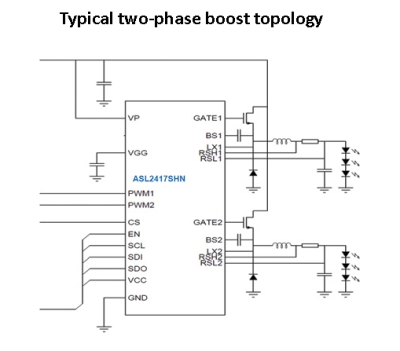There are numerous features in the electronics that power vehicular LEDs that you won’t find in other LED applications.
Jatin Thaker, Dave Strycharz | NXP Automotive
The automotive market is quickly moving away from traditional incandescent lighting towards more intelligent systems that promote reduced energy use, safety, and individualization options that boost brand recognition. Automotive LEDs now extend their light range, automatically adapt beam patterns to changing traffic situations, and last longer than older lighting technology. Automotive lighting systems are also changing to support autonomous driving functions with dynamic front lighting or glare-free high-beams for pedestrians and lane markers.

Here’s one example of what LED drivers targeting vehicular uses can do: The NXP Matrix LED Controller (MLC) can drive LED segments and pixel arrays. A single chip drives 12 LEDs, 32 chips will drive 384 LEDs. This matrix driver chip could let future LED headlight systems put on their own small-scale version of a drive-in theater experience. The idea is to individually control each LED in the headlights to, say, spell out “Ford” or “BMW” on a garage wall when the car starts. Features of the MLC that distinguish it from other kinds of LED applications include a limp-home mode – if the driver loses its connection with the vehicle central controller at start-up or in steady state operation, the LED headlights stay turned on. The chip can also detect and diagnose open/short conditions in each LED and implements a bypass feature.
LED drivers for the automotive market are designed with reliability requirements of the industry in mind. Products must be qualified according to AEC-Q100, which is a failure mechanism-based stress test qualification for integrated circuits. This qualification means automotive LED drivers are reliable and have a long lifetime in high ambient temperatures and in challenging electromagnetic compatibility (EMC) situations.
Automotive LED drivers also sport several facilities not found in drivers aimed at other uses. For one thing, smart LED drivers can communicate with other vehicle electronics and exchange essential data for lighting control. Also built-in is a means of configurability, as well as diagnostics to support functional safety requirements at the system level specified by ISO 26262 standards. The ability to monitor LED operation allows for accurate control, promoting light uniformity and protective measures such as on-chip temperature measurement, detection of lamp open, short circuits, and much more.
The extensive requirements and testing involved in vehicular applications generally force vehicle electronics to have a longer design cycle and production cycle than that of other applications. So it is important to capitalize on design re-use wherever possible. Also, industrial applications are often sole-purpose designs. This means the loads, lifetime and environment are all known and easily predictable. But this is rarely the case for automotive applications.
Consider an automotive headlamp module – it could be configured in multiple ways to accommodate different vehicle platforms, each with a different style and functions. In addition, automotive applications typically have requirements to ensure constant brightness and color, controllable brightness and built-in safety mechanisms. The challenge of dealing with ambient temperature and power dissipation and mechanical stress are also higher in automotive applications. NXP addresses this challenge with modular reference designs complete with inductors, capacitors and other components. These reference designs can then be scaled up or down to optimize feature sets for different platform models.

An evaluation board for the MLC chip from NXP and LED array boards. The eval board helps implement LED matrix operations that might find their way into vehicular LED headlights.
The LED driver module used for exterior vehicle lighting is driven from the 12-V car battery and is specifically designed to handle high power, around 150 W. The power output requirement is specified by the OEM. But in general, output must remain constant down to 9 V and can have some diminished operation down to 6 V.
For consumer or domestic uses, power requirements vary widely. There are low-power dc-dc converters for mobile handhelds, medium-range power requirements for home LED lamps, and applications like solar street lighting may have reasonably high wattage.
Today it is possible for automotive solid-state lighting (ASSL) systems to power multiple groups of loads more efficiently- say LED, OLED and laser diodes in the same lighting module. The light control unit (LCU) usually contains a microcontroller and one or more transceivers to communicate with the body control module (BCM). A boost voltage regulator and an independent constant-current source will drive different LED or laser diode functions. As it is a two-stage topology, the voltage source is more stable for a wide range of battery conditions, but still able to respond to dynamic loads in each stage. The NXP boost driver IC can provide two independent voltages from one boost IC, controlled individually via an SPI interface, resulting in higher system efficiency and phase interleaving to deliver a higher overall power to the application.

LED drivers targeting automotive use include this two-phase boost converter. The two-phase mode reduces the size of the magnetic components for easier packaging. LED drivers in vehicle typically communicate with a remotely located vehicle computer. Consequently, this IC includes an SPI communication interface and a timeout function to detect a break in the SPI communication lines. If a problem arises, the IC can power the LEDs in a limp-home mode so the vehicle doesn’t lose its lighting.
The buck channel uses a hysteretic buck converter with an integrated bootstrap diode. This topology optimizes efficiency while delivering constant (controlled) current within an accuracy of ±5% across the temperature range of -40 to 125°C. A flexible platform for multi-channel automotive LEDs allows an efficient combination of loads driven with a common architecture, so all LED string configurations and matrix, or segment switching, can be driven through one platform.
LED drivers go beyond simple road illumination. They are electronically managed to combine the power and data processing that is essential for ADAS applications. This is seen in dynamic lighting, marker beams, laser and high-current LED spots that use dynamic switching of individual LEDs or segment LED control. Such tasks require a large amount of real-time information exchange with the BCM. One key challenge for these types of applications is in delivering the high number of channels, signal processing, and necessary functions. These needs put a strong focus on thermal management and system efficiency.


Leave a Reply
You must be logged in to post a comment.